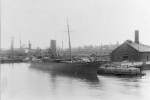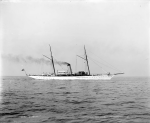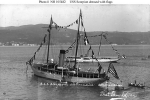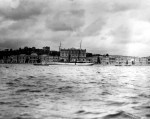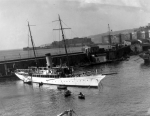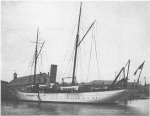NavSource Online:
Patrol Yacht Photo Archive
Scorpion (PY 3)
George - Rush - Have - Quack |
Nan - Tare - Tare |
ex-Gunboat Scorpion
ex-Patrol Yacht Scorpion
Nan - Sail - George
Patrol Yacht:
Specifications:
| Commanding Officers | ||
| 01 | LCDR Adolph Marix, USN - USNA Class of 1868 Retired as Rear Admiral | 11 April 1898 - 21 May 1898 |
| 02 | LCDR William Henry Turner, USN - USNA Class of 1869 | 21 May 1898 - 22 August 1899 |
| 03 | LCDR Nathan Sargent, USN - USNA Class of 1870 | 22 August 1899 |
| 04 | LCDR Clifford Joseph Boosh, USN - USNA Class of 1876 | 1 July 1902 |
| 05 | LCDR Hilary Pollard Jones, Jr., USN - USNA Class of 1884 Awarded the Distinguished Service Medal - Retired as Admiral | 11 June 1905 |
| 06 | LCDR Frank Woodruff Kellogg, USN - USNA Class of 1879 | 1907 |
| 07 | LT Allen Buchanan, USN - USNA Class of 1899 Awarded the Medal of Honor (1914) and the Navy Cross (1918)- Retired as Captain | 1908 |
| 08 | LCDR Walter Selwyn Crosley, USN - USNA Class of 1893 Retired as Rear Admiral | 26 February 1909 |
| 09 | LCDR George Wood Logan, USN - USNA Class of 1887 | 1910 |
| 10 | LCDR Frank Brooks Upham, USN - USNA Class of 1893 Retired as Rear Admiral | 21 February 1912 - 2 January 1913 |
| 11 | LCDR Edward McCauley, Jr., USN - Awarded the Navy Cross (1920) | 2 January 1913 |
| 12 | LCDR William F. Bricker, USN - USNA Class of 1900 | 14 March 1915 |
| 13 | CDR Herbert Stephens Babbitt, USN - USNA Class of 1906 | 20 March 1915 |
| 14 | CDR James Proctor Morton, USN - USNA Class of 1895 | 24 June 1915 |
| 15 | LT William Owen Baldwin, USN | 3 July 1917 - 27 October 1917 |
| 16 | CDR Richard Philip McCullough, USN - USNA Class of 1904 | 27 October 1917 - 1918 |
| 17 | CDR Elmer Wayne Tod, USN | 1919 |
| 18 | LT Samuel Russell Deets, USN - USNA Class of 1915 | 1919 - 1 June 1920 |
| 19 | LCDR Guy Evans Baker, USN - USNA Class of 1907 | 1 June 1920 - 10 November 1921 |
| 20 | CAPT Robert William Henderson, USN - USNA Class of 1904 | 10 November 1921- 26 October 1922 |
| 21 | LCDR Arthur Samuel Dysert, USN - USNA Class of 1909 | 26 October 1922 - 26 January 1924 |
| 22 | CDR Alfred Walton Atkins, USN - USNA Class of 1907 | 26 January 1924 |
|
|
View Scorpion (PY-3) Library of Congress Images
Following commissioning, Scorpion proceeded to Hampton Roads where she joined the Flying Squadron on 1 May and prepared for duty in the Caribbean. On the 22d, she arrived with the squadron off Cienfuegos, Cuba, then continued on to the Santiago area with dispatches for ships scouting off that port. On the 25th the day after war against Spain had been declared, she returned to Cienfuegos; patrolled on blockade until the next day; then sailed for Key West for coal and water.
On 7 June, Scorpion sailed south, escorted a provisions ship and an ammunition ship to Santiago; then, until the 22d, performed blockade duties off the harbor there. On the 22d, she assisted in clearing the beach at Daiquiri in preparation for an army landing and, on the 23d, carried out a similar mission at Siboney. On the 24th, she resumed blockade duties off Santiago. On the 30th, she shifted to Cape Cruz, and, on 1 July, she joined Osceola in an unsuccessful attack on Spanish gunboats in Manzanillo harbor. After the attack, she retired to waters off the entrance, captured a provisions lighter, and patrolled there until the 5th.
Scorpion then proceeded to Guantanamo for water, coal, provisions, and ammunition. She returned to Manzanillo on the 11th, and, seven days later, participated in another attack which destroyed all Spanish Government vessels then in the harbor.
After the second attack on Manzanillo, Scorpion resumed blockade duties, continued them until 3 August; then returned to Guantanamo, whence she carried dispatches for the remainder of the war.
On 27 November, Scorpion departed Cuban waters. A month later, she arrived at New York and, on 14 January 1899, she was decommissioned in preparation for conversion to a gunboat. Recommissioned on 22 August, she was assigned to the Isthmian Canal Commission and ordered south. Into the spring of 1900, she remained in the Caribbean as the Commission investigated the proposed canal routes. In June, she returned to the United States, operated off the northeast coast into the fall, then resumed operations in the Caribbean. From November 1900 to May 1901, she cruised off Hispaniola. In June, she arrived at Boston; and, on 24 July, she was again decommissioned.
On 1 July 1902, the gunboat was recommissioned and assigned to the North Atlantic Squadron. For the next six years, she carried dispatches and personnel, conducted hydrographic surveys, and participated in exercises along the east coast and in the Caribbean, operating primarily off Santo Domingo during 1906 and 1907.
Ordered to the Mediterranean in 1908, Scorpion sailed from Philadelphia on 22 October. On 4 December, she arrived at Constantinople to take up duties as station ship; but, on the 21st, she was ordered to Messina, Italy, to assist in relief efforts for the survivors of an earthquake there. She supported International Medical Service efforts from 3 to 8 January 1909, then steamed back to Turkey. From 10 February until 15 July, she was at Naples for repairs. She returned to Constantinople on the 20th and assumed station ship duties, which included work for the United States Embassy. From 27 November 1910 to 28 January 1912, she was at Trieste for extensive repairs, and, in February, she returned to Constantinople. In August, she assisted Turkish earthquake victims and in October, as the first Balkan War broke out, she commenced operations to assist Americans caught in disputed areas.
Through that six-month war and the second Balkan War, which followed in the summer of 1913 and set the stage for the incident at Sarajevo in 1914, Scorpion continued to protect American interests. After the wars, she assisted the international commissions which gave aid to refugees and displaced persons.
During the first years of World War I Scorpion was held at Constantinople and, on 11 April 1917, after the United States had entered the war on the side of the Allies, she was interned. Under Turkish guard from 15 November 1917, she was allowed to assist British personnel released from POW camps in the interior of Turkey during late October 1918. On 9 November, she was allowed to resume her previous activities and soon thereafter began assisting the many refugees in the area.
With the arrival of Rear Admiral Mark L. Bristol High Commissioner to Turkey and Senior U.S. Naval Officer in Turkish Waters, Scorpion assumed duties as flagship and dispatch vessel, continuing, at the same time, her station ship and relief work. Designated PY-3 in 1920, she shifted to Phaleron Bay, Greece, in November 1923 and took up duties as station ship in the eastern Mediterranean. On 16 June 1927, she departed the Mediterranean and steamed west. On 11 July, she arrived at Philadelphia, where she was decommissioned on 27 October 1927. Struck from the Navy list on 23 March 1929, she was sold to the Boston Iron and Metal Co., Baltimore, Md., on 25 June of the same year.
Addendum: Constantinople, (22 March 1915) – Lieut. Commander William F. Bricker of the United States converted yacht Scorpion and three sailors named Ford, Dowell, and Leverings were drowned on the night of March 20 while attempting to reach their vessel in a rowboat. The Scorpion was anchored in the Bosporus off Constantinople, near in Dolma Bagtchi Palace. The rowboat was swamped in a heavy sea thrown up by a south gale. Lieut. Herbert S. Babbitt and one sailor, who were in the boat, were saved. Bricker’s body was the only one recovered of the drowning victims. Lieut. Commander Bricker arrived at Constantinople on March 16 to succeed Lieut. Commander Edward McCauley, Jr. in command of the Scorpion. Text copyright of the New York Times published March 23, 1915
| Back to the Main Photo Index | Back to the Patrol Craft/Gunboat/Submarine Chaser Ship Index | Back to the Patrol Gunboat Photo Index | Back to the Patrol Yacht (PY) Photo Index |
| Comments, Suggestions, E-mail Webmaster |
|
This page created by Gary P. Priolo and maintained by Tom Bateman |

